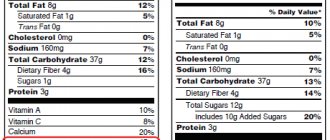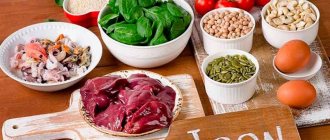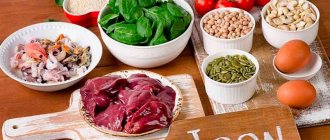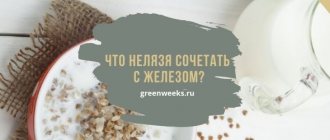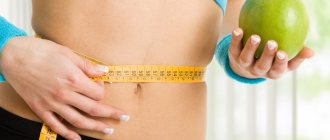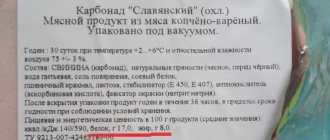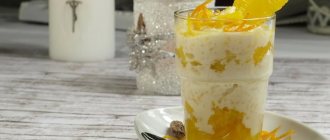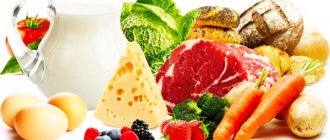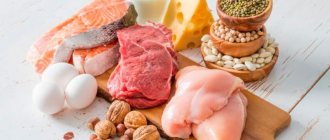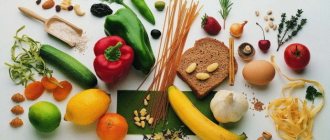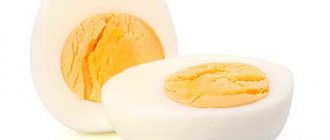Author
Anna Shelestun
Checked by an expert
Tatyana Eliseeva
- Symptoms of iron deficiency
Iron is a trace element necessary for transporting oxygen and removing carbon dioxide. When nutrient reserves in the body are greatly reduced, cells receive less oxygen and iron deficiency anemia (IDA) develops. To prevent this from happening, you need to eat more iron-containing foods. The problem is that they are absorbed differently and absorption can be as low as 2%.
Why does the body need iron: reserves and functions
The body does not produce the substance, but only processes and stores:
- 70% is in hemoglobin, and the remainder is in the form of ferritin in the liver, spleen, muscle tissue and bone marrow;
- the hormone hepcidin regulates its absorption and distribution in the body;
- The microelement is delivered throughout the body by transferrin, a protein in the blood plasma. [1]
People lose the mineral in small quantities through urine and feces. Large losses occur when blood is lost, due to which many menstruating women suffer from deficiency. [2]
How to identify anemia: tests that show iron deficiency
Typically, a doctor confirms IDA using a complete blood count (CBC), or more precisely, tests for hemoglobin and hematocrit. Other indicators help identify the problem in the early stages, determine the severity of the condition and the method of treatment:
- size and color of red blood cells;
- serum ferritin;
- vitamin B12.
In anemia, hematocrit and hemoglobin levels are low and red blood cells are smaller than normal in size. Low ferritin levels indicate low iron stores and are a precursor to anemia, so it is advisable to check it as often as possible.
Iron in food - types and digestibility
The mineral is found in food in two forms:
- Heme. Absorbed by the body up to 40%. This type of iron comes from animal protein - found only in meat, poultry, organ meats and seafood (fish, shellfish, etc.).
- Non-heme. Has low bioavailability of 2–20%. Found in plant foods and animals because animals eat plant foods. [3]
The absorption of the component is complex and some foods enhance this process, while others suppress it.
What foods are rich in iron?
Sources of iron are all kinds of plant and animal foods. When choosing, it is advisable to focus on the norm. An excess of a microelement is just as dangerous as a deficiency. 12 - 15 mm with an average weight of 70 kg - this is the daily norm for adults.
The best foods containing large quantities of iron are meat. The leaders are by-products. 100 g of pork, chicken, and beef liver more than covers the body’s daily need for the mineral.
There is a lot of iron in rabbit meat, beef brains, pork heart, beef tongue (4 to 6 mg).
Dried mushrooms are the leading plant products. 100 g contains double the daily requirement of the microelement - 35 mg. They are followed by seaweed - 16 mg, prunes - 13 mg. There is a lot of it in dried apricots, beans, cocoa powder, lentils, rose hips, dried apples - from 11 to 12 mg.
The body's use of a microelement and its absorption through the intestinal walls largely depends on the composition of the food consumed at one time.
Absorption is promoted by ascorbic acid. Calcium carbonate, phosphates, magnesia, and baking soda reduce digestibility.
This fact should be taken into account when creating a menu. By combining meat foods with vegetables, rosehip decoction, juices and other dishes rich in vitamin C, you can replenish the deficient element.
Read in detail: The role of iron in the body (norms)
The only good apples are the ones that are wormy.
Since childhood, our grandmothers told us: “if a worm chose this apple, it means it is natural, without chemicals.” And until now, most people are sure that wormy apples were not treated with chemicals during ripening. But experienced gardeners refute this myth. In fact, a wormy apple could have been treated with chemicals ten times more than a non-wormy one, it was just that the apple tree could have been processed at the wrong time.
In addition, farmers are now using organic processing methods. As a result, good apples, on the contrary, may not have worms. Therefore, it makes no sense to judge the quality of the product by their presence.
Table of iron content per 100 g of product
In the table, products are listed in descending order of microelement.
| Product | Iron mg | Product | Iron mg |
| Dried mushrooms | 35,0 | Cashew nuts | 6,1 |
| Pork liver | 20,2 | Peanut | 6,1 |
| Chicken liver | 17,5 | Beef brains | 6,0 |
| Brewer's yeast | 17,3 | Parsley | 5,9 |
| Sea kale | 16,0 | Fresh mushrooms | 5,2 |
| Dried apples | 15,0 | Beef tongue | 5,0 |
| Pumpkin seeds | 15,0 | Beef heart | 4,8 |
| Dried pear | 13,0 | Rabbit meat | 4,4 |
| Prunes | 13,0 | Pork heart | 4,1 |
| Beans | 12,4 | Peach | 4,1 |
| Cocoa | 12,2 | Oatmeal | 4,0 |
| Dried apricots | 12,0 | Cranberry | 3,7 |
| Lentils | 12,0 | Peaches | 3,7 |
| Dried apricots | 11,7 | Dates | 3,6 |
| Rose hip | 11,0 | Sturgeon caviar | 3,4 |
| Veal liver | 11,0 | Mutton | 3,1 |
| Oysters | 9,2 | Canned sardines. | 2,9 |
| Buckwheat | 8,0 | Fresh apples | 2,2 |
| Blueberry | 8,0 | Pork | 1,8 |
| Cereals | 7,8 | Chicken's meat | 1,6 |
| Cowberry | 7,0 | Turkey meat | 1,4 |
| Beef liver | 6,9 | Canned tuna | 1,4 |
| Egg yolk | 6,4 | Carrot | 1,2 |
| Almond | 6,1 | Cabbage protein. | 1 |
Pineapples burn fat
You can often hear that pineapples burn fat, which means the pineapple diet is an easy way to lose weight. Manufacturers of weight loss products immediately took advantage of this myth, creating drugs based on pineapple extract. In fact, if you go on a pineapple diet, you will not feel any stunning effect. The thing is that the enzyme bromelain, which is credited with miraculous properties, is capable of breaking down only proteins, but not fats.
Pineapples are not able to burn fat cells and do not help you lose weight.
The bromelain molecule is very large and is unable to “pass” through the intestinal wall. In addition, the enzyme is broken down in the stomach and intestines, losing its properties. The myth about the pineapple is well known to residents of Western Europe, whose “pineapple mania” ended 20 years ago. People have come to the conclusion that the best way to lose weight is a healthy diet, about which there are no less myths than about fruits.
If you care about your health and try to eat right, be sure to subscribe to our Yandex.Zen channel, where we regularly tell you which foods are really healthy and which ones you should avoid.
Some dried fruits contain as many calories as candy
Iron in foods for pregnant women and children
The amount of iron in foods for pregnant women is 30 mg per day. For a six-month-old child, the same figure is 12–16 mg. Insufficient intake of microelements from food is dangerous for the health of the fetus and mother.
The main supplier of iron is lean meat and offal - liver, beef tongue, heart.
If there are no contraindications, the menu includes nuts, eggs, blueberries, lingonberries, cranberries, and salads with seaweed. Drinks include rosehip infusion, apple, peach, and apricot juices. Compotes with dried fruits - prunes, dried apricots, apples, pears - are useful. You need oatmeal, buckwheat porridge, dishes with lentils and peas. For children, products are selected according to age and on the recommendation of a doctor.
Daily iron intake
Women aged 19–50 need iron the most. They need to receive at least 18 mg of microelement per day. During pregnancy, the need for it increases to 27 mg. Adolescents 14–18 years old also require increased iron levels: girls - 15 mg, boys - 11 mg. The average daily iron intake for adult men and older adults of both sexes is 8 mg. It increases significantly with intense sports, regular heavy physical activity and heavy menstruation.
High iron foods for anemia
There are several types of anemia, all of them are associated with a decrease in the number of red blood cells in the blood and a decrease in hemoglobin. Since animal food is better absorbed, in case of anemia, preference is given to it.
The microelement is found in large quantities in:
- pork, chicken, veal liver;
- beef tongue;
- beef heart;
- beef brains;
- oysters;
- egg yolk.
Along with meat, plant foods that increase hemoglobin are an obligatory component of the daily menu. Blood is normalized by consuming buckwheat and oatmeal, prunes, dried apricots, lentil dishes, peas, and seaweed.
Read - what is gluten: Table of gluten content in products
Hemoglobin will be normal if you properly organize your diet and provide the body with nutrients, vitamins, macro and microelements every day. Food containing enough iron is an excellent prevention of new and old (in the acute stage) iron deficiency pathologies.
Why do you need iron?
Let's say right away: if you don't have enough iron, get ready for trouble. For example, like this Iron Deficiency Anemia / Mayo Clinic:
- weakness;
- constant fatigue;
- shortness of breath at the slightest exertion;
- dizziness;
- brittleness of hair and nails;
- cold hands and feet;
- pallor and circles under the eyes.
All these are signs of iron deficiency anemia. That is, a condition in which your body, due to a lack of iron, cannot produce a sufficient amount of hemoglobin - a protein that transports oxygen from the lungs to all organs and tissues, and the released carbon dioxide in the opposite direction.
Relatively speaking, without enough iron, the body suffocates. But oxygen delivery is not the only process that requires this microelement.
Iron is involvedN. Abbaspour, R. Hurrell, R. Kelishadi. Review on iron and its importance for human health / Journal of Research in Medical Sciences in a lot of reactions on which metabolism as a whole is based. Not only the physical condition of the body, but also immunity and intellectual performance depend on it.
To stay healthy, you need to get Iron/Office of Dietary Supplements (ODS) of the US National Institutes of Health (NIH) 10–20 mg of iron every day. In pregnant women and those who regularly donate or otherwise lose blood, the norm increases to 28 mg.
An important point: the human body cannot synthesize iron on its own. We can only get it from food. Lifehacker has compiled a list of foods high in iron. Try to consume at least some of them daily to reduce the risk of iron deficiency anemia and other problems.
Turkey
Turkey meat is a healthy and tasty food. It is also a good source of iron, and dark meat contains more iron than white meat.
A 100-gram serving of dark meat turkey contains 1.4 mg of iron, which is 8% of the recommended daily value.
By comparison, the same amount of white turkey meat contains only 0.7 mg of iron.
Dark meat turkey also contains an impressive 28 grams of protein per serving and several B vitamins and minerals, including zinc—32% of the recommended daily value—and 57% selenium.
Eating high-protein foods like turkey can help with weight loss because protein helps you feel full and increases your metabolic rate.
The role of trace elements in the body
Iron has many functions, but there are two main ones: transport of oxygen to all cells of the body and participation in metabolic processes.
- It is part of the formula of hemoglobin, a protein that carries oxygen. Accordingly, with a deficiency, the amount of hemoglobin in the blood decreases, and body cells experience hypoxia.
- The trace element is a component of many enzymes involved in metabolic processes. These biologically active substances are necessary for the processes of breakdown and synthesis, and the disposal of toxins. Therefore, when there is a “shortage,” hair does not grow, skin does not renew, well-being worsens—there is not enough energy.
Pumpkin seeds
Pumpkin seeds are a delicious and healthy snack.
An 8-ounce serving of pumpkin seeds contains 2.5 mg of iron, which is 14% of the recommended dose.
Additionally, pumpkin seeds are a good source of vitamin K, zinc and manganese. They are also among the best sources of magnesium.
Legumes
The most common types of legumes are beans, lentils, chickpeas, peas and soybeans. All of them are rich in nutrients.
Legumes are an excellent source of iron, especially for vegetarians. One cup of 198 grams of cooked lentils contains 6.6 mg, which is 37% of the daily recommended value.
And an 86-gram serving of cooked black beans provides about 1.8 grams of iron, or 10% of the recommended daily intake.
Legumes are also a good source of folic acid, magnesium and potassium.
In addition, legumes can help you lose weight because they are rich in fiber, which increases the feeling of fullness and therefore reduces the number of calories you consume.
To maximize iron absorption, eat legumes with foods high in vitamin C, such as tomatoes, leafy greens, or citrus fruits.
Deficiency Symptoms
An extreme manifestation of the situation is the state of iron deficiency anemia, when the level of hemoglobin decreases significantly and the body falls into a state of permanent lack of oxygen. We have compiled a list of symptoms:
- prostration;
- dizziness, even fainting;
- frequent colds;
- dyspnea;
- irritability;
- difficulty concentrating;
- constipation;
- pallor of the face, palms and bases of the nail plates;
- fragile, thin nails, curved nail plates;
- hair loss over a long period (from 3 months).
According to WHO, about 60% of Russians suffer from iron deficiency, and about 30-15% suffer from iron deficiency anemia.
Shellfish
All shellfish are rich in iron, which is well absorbed by the body. This especially applies to oysters and mussels.
A 100-gram serving of shellfish can contain up to 3 mg of iron, which is 17% of the recommended daily value, 26 grams of protein, 24% of the daily value of vitamin C and five times the recommended daily value of vitamin B12.
Shellfish are not only rich in nutrients, but also delicious.
Red meat
A 100-gram serving of ground beef contains 2.7 mg of iron, which is 15% of the recommended daily intake.
The meat is also rich in protein, zinc, selenium and several B vitamins.
In fact, red meat is perhaps the most readily available source of easily absorbed iron, potentially making it an important food for people prone to anemia.
In a study looking at changes in body iron stores after aerobic exercise, women whose diet included meat retained better iron than those who took iron supplements.
What affects iron absorption
It seems that in order to compensate for iron deficiency, it is enough to include foods containing this trace element in your diet. However, when combined with certain types of foods containing calcium, tannin and polyphenols, they can interfere with the active absorption of iron.
Accordingly, dairy products rich in calcium not only do not contain iron, but can also interfere with its active absorption. If you are a big fan of coffee and strong tea, it is recommended to avoid these drinks immediately after meals, as caffeine also interferes with the body's ability to absorb iron. The same goes for Coca-Cola - don’t get carried away with this product, it’s better to replace it with rosehip decoction, dried fruit compote and other healthy drinks.
Vitamin C increases the absorption of plant iron by 2 times.
Which apples have a lot of iron?
No matter how often they say that apples are the best and most accessible source of iron, do not forget that their different varieties contain completely different amounts of this trace element. The most “iron” variety is the well-known winter variety Semerenko. In general, if you set yourself the goal of replenishing iron reserves by eating apples, give preference to green varieties.
By the way, green apples have one big advantage - they contain a decent amount of vitamin C, in combination with which iron is absorbed much better.
Inside your favorite cartoons: the interactive Soyuzmultpark opened at VDNKh
Instead of lemon or vinegar: a useful life hack with vanilla for the microwave
Russians have improved their culinary skills and began spending more time with their families.
Absorption of iron from food products (Korovina N.A. et al., 2004)[edit | edit code]
| Product | Iron absorption coefficient , % |
| Rice | 1 |
| Beans | 2-3 |
| Spinach | 1 |
| Fruits | 2-3 |
| Egg | 2-3 |
| Fish | 9—11 |
| Liver | 12-16 |
| Veal | 22 |
